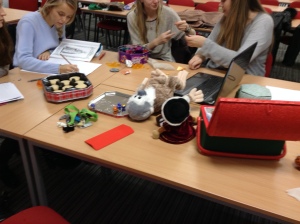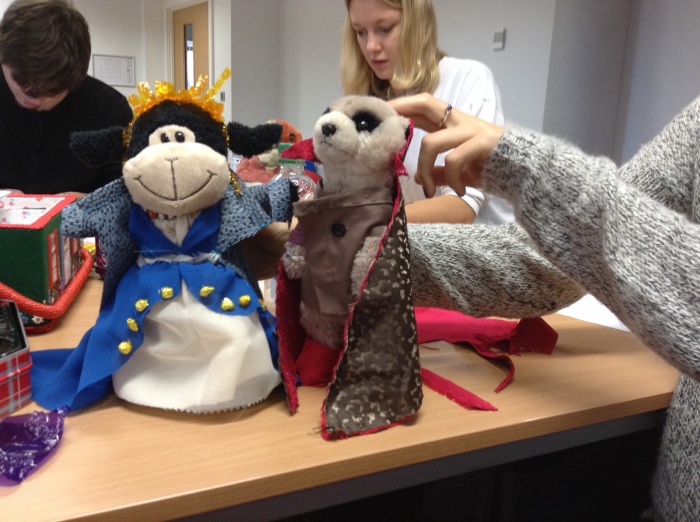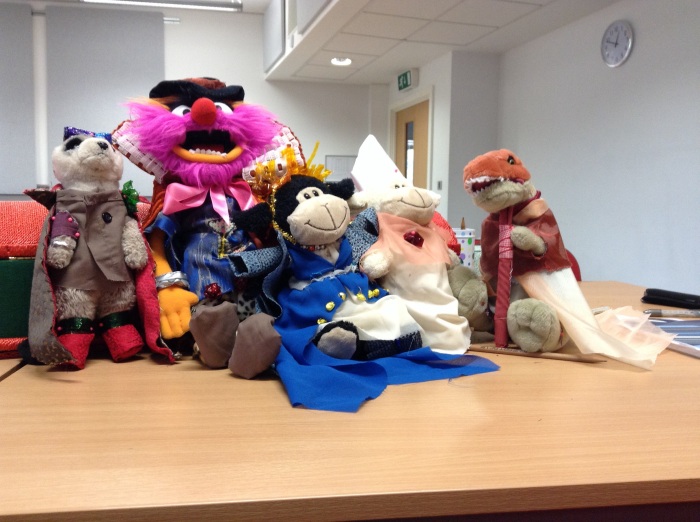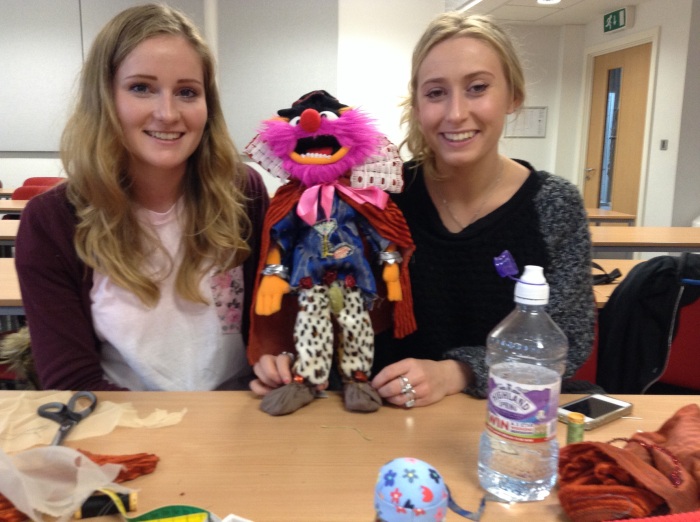Doing the Play Again for Renaissancs
1 of the modules I am instruction for finalists is quite a challenge from the point of view of delivering it. 'Renaissance luxuries' takes, in a style, information technology's inspiration both from Richard Goldthwaite's work on Wealth and the Need for Fine art in Renaissance Italy, and AD Fraser Jenkins' musings on magnificence. In the course of a semester, I range quite widely across a range of genres and materials, and wait at what constituted a luxury detail in the Renaissance and what their possession and consumption meant for their owner. And so, you could argue that the 3rd theoretical plank for this module is Stephen Greenblatt'south concept of self- fashioning; as a concept, it certainly helps with thinking through some of the issues.
A tight theoretical framework is certainly a necessity for this particular module, as the focus on case studies shifts on a weekly ground, and then while we might be looking at villeggiatura and maybe the gardens of the Villa d'Este one calendar week, we are just as likely to be studying glass or Western farsi rugs the next. There is a lot of material to go your head round, coming very fast, and that only works if the theoretical frameworks provide a chip of stability and coherence to the delivery of this module. The students on the module 'specialise' in a particular type or grouping of objects for their coursework and seminar contribution, then again, the pressure for me is to make the lectures and seminars cohere and function fifty-fifty if not all of the grouping has washed the cardinal readings.
This module then is 1 of the toughest but also one of the most rewarding modules I teach as each seminar needs a distinctly different approach, so my responses accept to be maybe more imaginative than they are for some of my other teaching. A good case for this is the seminar on Renaissance wearing apparel and sumptuary legislation. Renaissance images are wonderful sources of information on Renaissance outerwear, on the most visible and almost ostentatious layers of wearable worn by their subjects, only is this the full story? Of course non. At that place is some superb scholarship on Renaissance vesture, and basically, information technology becomes clear from these sources that yous build your outfit upwardly from a shift-like undergarment, normally plain, perchance embroidered effectually cuffs and neck, but basically, this is your underwear, and what provides structure and oomph to the outfit is what goes on over it. But in case you are wondering: under it go stockings. No knickers. Now, this shift can occasionally peep out from under the over garments, just this is where yous start layering, and this is where colour, weight of material and shape beginning to matter. Renaissance clothing also functions like a modern capsule wardrobe in that you lot have a limited number of styles to choose from, but you tin can infinitely increment your options by interchanging sleeves, coats, cloaks etc. And finally, you beautify the clothes, then you add ribbons, embroidery, woven bands, pearls etc. Nonce of this clothing is bought 'off the rack', all is bespoke, and product is shared between domestic sewing and professional tailoring.
This sounds all very well when you work through a series of PowerPoint slides in a lecture, but I take observed that actually, the students accept not got their heads round the complexities of clothing at all, equally they can't visualize the process.
This is where some of my more than unusual didactics props come in:

soft toys getting ready for seminar!
Yes, I am not below raiding my children's toy box in an effort to bring instruction alive!
The mode I teach renaissance wearable is to use a 2 hr seminar slot, and ask students, in groups, to select a soft toy of their choice and to concord a Renaissance character for their toy. What is the gender of the toy? Where does it live? What does it need a particular outfit for? These questions from the starting point for the blueprint stage of the seminar, where the group work out what kind of outfit to brand for their character. And then, they make it.
Information technology's a preparation -heavy seminar that requires quite a few props; for my seminars with up to fifteen-18 students at a time, I need 3 sewing baskets with enough of needles, different coloured threads, fabric pair of scissors, chalk, cardboard, and measuring tapes. I always bring in an assortment of additional bits and pieces, often raiding my sewing handbasket at home, including metallic thread, buttons, feathers etc. Then, I need paper, pencils and erasers, both for designing but also occasionally for incorporating paper into the outfits ( great for calculation shape and texture). Most useful of all are piping cleaners as they tin provide shape to hats, or brand belts, or pretty much annihilation else, and my nearly important prop of all, a tin total of chocolate wrappers. Their lovely colours are great, and when rolled upward, they double up as buttons, as jewels, equally head ornaments. Actually, the possibilities are endless. And then there is material, lots and lots of different bits and pieces, in varying colours, textures, shapes and sizes.

sewing basket and props
In one case all that material is set out and the students have their instructions, the seminar runs itself, and before yous inquire, I am sat in the middle of the group sewing besides (I like making little Tudor hats for toy frogs), so I am part of the group, too, and can of form reply to questions. Sewing takes time, so this activity needs at to the lowest degree 60-75 minutes where the clothes can be worked on, and that is a procedure where a couple of packets of biscuits always go downward a care for (literally). I as well similar to play renaissance music, just to set the scene ( Thomas Tallis is a particular favourite), and off nosotros go. Sewing is difficult piece of work, so there tends to be both churr and a palpable sense of concentration when nosotros work; you lot tin also apace note a sense of competition between the groups, so the standard of work never ceases to amaze me, especially bearing in mind that this is a seminar for an art history module, and I can't rely on students having worked with textiles before.
The most interesting office of the seminar comes when the toys become their apparel fitted to them, equally hither each grouping explains, in plough, who their characters are, what they are wearing and why the outfits have been chosen. We talk colours, textures, ornaments, we look at the ways in which the clothes fit together, and all all of a sudden, the academic theories behind self- fashioning and sumptuary legislation are practised and worked with past the students themselves, applied and properly thought through. For me, it's the perfect seminar. It's fun, it's relaxed, information technology's participatory in that everybody works together, and it sticks. I always think that when you run across a educatee take out their telephone and photograph their handiwork, that is surely a articulate indicator of a successful session.
Have a look for yourself at what my lovely, committed, hard- working students did in their class this week. It's difficult to choose a favourite, but for sheer joie-de-vivre and utter and complete flamboyance, it volition exist difficult to beat out Animal, with his leopard peel trousers, floppy hat and codpiece. What do you recollect?
Selected Bibliography:
Richard Goldthwaite, Wealth and the Demand for Fine art in Italia 1300-1600 and Evelyn Welch, Art in Renaissance Italy 1350-1500 (earlier editions of Welch's written report were titled Art and Lodge in Italy 1350-1500. Both editions are essentially the same, with the later edition, from 2000, updated to include a number of spider web sites etc.).
For general interest, you might like to endeavor Rudolph M. Bell, How to Do Information technology: Guides to Good Living for Renaissance Italians. And, at that place are the bear manuals, most notably Baldassare Castiglione's The Courtier and Giovanni della Casa's Galateo or the Book of Manners.
"Nobody should undress, especially take off his hose in public, that is, where honest company is gathered. Nor is it desirable to comb 1's hair and wash ane's hands among other people, since these are things to be washed in the camera, and not in the open."
From a book of manners
(Giovanni Della Casa, Galateo, 1558)
A very readable source:
Glossary of Renaissance Dress and Textile Terms
Reading: Hughes, D.O, 'Sumptuary Police force and Social Relations in Renaissance Italia' in: John Bossy (ed.), Disputes and Settlements: Constabulary and Human Relations in the West (Cambridge Academy Press, 1983) :69-99; Killerby, C K, 'Practical Problems in the Enforcement of Italian Sumptuary Law, 1200-1500' in: Dean and Lowe (eds.), Crime, Society and the Constabulary in Renaissance Italy (Cambridge University Press, 1994): 99-120; Cherry-red, J, 'Healing through religion: the continuation of medieval attitudes to jewellery into the Renaissance', Renaissance Studies, xv, 2001: 154-71; Duits, R, '"Figured Riches": The value of gold brocades in Fifteenth-Century Florentine Painting', Journal of the Warburg and Courtauld Institutes, 62, 1999: 60-92; Frick, CC, Dressing Renaissance Florence: Families, fortunes and fine clothing (Baltimore and London: The Johns Hopkins University Press, 2002), C.Yard. KILLERBY, "Heralds of a Well-Instructed Listen: Nicola Sanuti'southward defence of Women and their clothes", Renaissance Studies, vol. xiii, 1999, pp.225-82

Sheep and Meerkat

Grouping Photograph!

Renaissance Beast and his way design team
vizcarrondohiday1991.blogspot.com
Source: https://renaissanceissues.wordpress.com/2013/10/30/teaching-by-doing-making-renaissance-clothes-for-soft-toys/
0 Response to "Doing the Play Again for Renaissancs"
Post a Comment